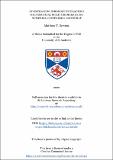Files in this item
Investigating strongly interacting multicritical field theories using numerical conformal bootstrap
Item metadata
| dc.contributor.advisor | Hooley, Chris | |
| dc.contributor.author | Dowens, Matthew | |
| dc.coverage.spatial | 198 p. | en_US |
| dc.date.accessioned | 2022-11-14T10:14:42Z | |
| dc.date.available | 2022-11-14T10:14:42Z | |
| dc.date.issued | 2022-11-29 | |
| dc.identifier.uri | https://hdl.handle.net/10023/26382 | |
| dc.description.abstract | In strongly correlated quantum systems, conventional techniques for understanding physical behaviour near multicritical points break down. Numerical conformal bootstrap is a promising new method that has proven demonstrably useful in investigating critical phenomena. The method uses the enhanced conformal symmetry exhibited by quantum field theories describing criticality in order to definitively rule out theories based on fundamental symmetry grounds alone. By requiring only that physically plausible conformal field theories (CFTs) satisfy a mathematical self-consistency relation, it allows one to rule out vast amounts of violating CFT data, allowing a rigorous mapping to made of ‘allowed’ CFTs. Such a mapping is powerful due to the concept of universality, whereby the critical behaviour of many disparate physical models is identical and is captured by the same set of critical exponents and the same CFT. This thesis aims to explore the effectiveness of numerical bootstrap. We begin by motivating the bootstrap in a condensed matter context, before reviewing necessary results in the conformal field theory literature and establishing the bootstrap method. A large part of the thesis will be an overview of the working of the method and the approximations made, as well as its applications to simple symmetry groups. We will demonstrate the validity of the method by replicating flagship results, before describing the novel work we have carried out in exploring more complicated global symmetry groups, where more than one fixed point is predicted. Finally, we will conclude and comment on the limitations of the thesis and lines of possible future work. | en_US |
| dc.language.iso | en | en_US |
| dc.rights | Creative Commons Attribution-NonCommercial-NoDerivatives 4.0 International | * |
| dc.rights.uri | http://creativecommons.org/licenses/by-nc-nd/4.0/ | * |
| dc.subject | Conformal symmetry | en_US |
| dc.subject | Conformal field theory | en_US |
| dc.subject | Conformal bootstrap | en_US |
| dc.subject | Phase transitions | en_US |
| dc.subject | Critical phenomena | en_US |
| dc.subject | Renormalisation group | en_US |
| dc.subject | High energy physics | en_US |
| dc.title | Investigating strongly interacting multicritical field theories using numerical conformal bootstrap | en_US |
| dc.type | Thesis | en_US |
| dc.contributor.sponsor | Engineering and Physical Sciences Research Council (EPSRC) | en_US |
| dc.type.qualificationlevel | Doctoral | en_US |
| dc.type.qualificationname | PhD Doctor of Philosophy | en_US |
| dc.publisher.institution | The University of St Andrews | en_US |
| dc.identifier.doi | https://doi.org/10.17630/sta/221 | |
| dc.identifier.grantnumber | EP/R513337/1 | en_US |
The following licence files are associated with this item:
This item appears in the following Collection(s)
Except where otherwise noted within the work, this item's licence for re-use is described as Creative Commons Attribution-NonCommercial-NoDerivatives 4.0 International
Items in the St Andrews Research Repository are protected by copyright, with all rights reserved, unless otherwise indicated.


